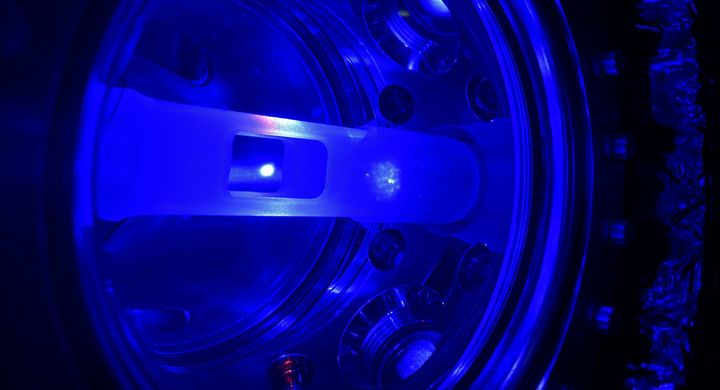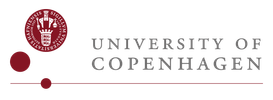Superradiant atoms could push the boundaries of how precisely time can be measured
Superradiant atoms can help us measure time more precisely than ever. In a new study, researchers from the University of Copenhagen present a new method for measuring the time interval, the second, mitigating some of the limitations that today’s most advanced atomic clocks encounter. The result could have broad implications in areas such as space travel, volcanic eruptions and GPS systems.

The second is the most precisely-defined unit of measurement, compared to other base units such as the kilogram, meter, and degree Kelvin. Time is currently measured by atomic clocks in different places around the world, which together, tell us what time it is. Using radio waves, atomic clocks continuously send signals that synchronize our computers, phones and wristwatches.
Oscillations are the key to keeping time. In a grandfather clock, these oscillations are from a pendulum's swinging from side to side every second, while in an atomic clock, it is a laser beam which corresponds to an energy transition in strontium and oscillates about a million billion times per second.
But according to PhD fellow Eliot Bohr from the Niels Bohr Institute – great-grandson of Niels Bohr – even atomic clocks could become more precise. This is because the detection laser, used by most modern atomic clocks to read the oscillation of atoms, heats up the atoms so much that they escape – which degrades precision.
"Because the atoms constantly need to be replaced with fresh new atoms, while new atoms are being prepared, the clock loses time ever so slightly. Therefore, we are attempting to overcome some of the current challenges and limitations of the world’s best atomic clocks by, among other things, reusing the atoms so that they don’t need to be replaced as often," explains Eliot Bohr who was employed at the Niels Bohr Institute when he did the research, but who is now PhD fellow at the University of Colorado.
He is the lead author of a new study published in the scientific journal Nature Communicationswhich uses an innovative and perhaps more efficient way of measuring time.
Superradiance and cooling to absolute zero
The current methodology consists of a hot oven that spits roughly 300 million strontium atoms into an extraordinarily chilly ball of cold atoms known as a magneto-optical trap, or MOT. The temperature of these atoms is approximately -273 °C – very near absolute zero – and there are two mirrors with a light field in between them to enhance the atomic interactions. Together with his research colleagues, Bohr has developed a new method to read out the atoms.
"When the atoms land in the vacuum chamber, they lie completely still because it is so cold, which makes it possible to register their oscillations with the two mirrors at opposing ends of the chamber," explains Eliot Bohr.
The reason why the researchers don’t need to heat the atoms with a laser and destroy them is thanks to a quantum physical phenomenon known as 'superradiance'. The phenomenon occurs when the group of strontium atoms is entangled and at the same time emits light in the field between the two mirrors.
"Themirrors cause the atoms to behave as a single unit. Collectively, they emit a powerful light signal that we can use to read out the atomic state, a crucial step for measuring time. This method heats up the atoms minimally, so it all happens without replacing the atoms, and this has the potential to make it a more precise measurement method," explains Bohr.
GPS, space missions and volcanic eruptions
According to Eliot Bohr, the new research result may be beneficial for developing a more accurate GPS system. Indeed, the roughly 30 satellites that constantly circle Earth and tell us where we are need atomic clocks to measure time.
"Whenever satellites determine the position of your phone or GPS, you are using an atomic clock in a satellite. The precision of the atomic clocks is so important that If that atomic clock is off by a microsecond, it means an inaccuracy of about 100 meters on the Earth’s surface," explains Eliot Bohr.
Future space missions are another area where the researcher foresees more precise atomic clocks making a significant impact.
"When people and crafts are sent out into space, they venture even further away from our satellites. Consequently, the requirements for precise time measurements to navigate in space are much greater," he says.
The result could also be helpful in the development of a new generation of smaller, portable atomic clocks that could be used for more than "just" measuring time.
"Atomic clocks are sensitive to gravitational changes and can therefore be used to detect changes in Earth's mass and gravity, and this could help us predict when volcanic eruptions and earthquakes will occur," says Bohr.
Bohr emphasizes that while the new method using superradiant atoms is very promising, it is still a "proof of concept" which needs further refinement. .
The research was conducted by the team of Jörg Helge Müller and Jan Thomsen at the Niels Bohr Institute, in collaboration with PhD students Sofus Laguna Kristensen and Julian Robinson-Tait, and postdoc Stefan Alaric Schäffer. The project also included contributions from theorists Helmut Ritsch and Christoph Hotter from the University of Innsbruck, as well as Tanya Zelevinsky from Columbia University. This work underscores the importance of international collaboration in the sciences.
Contact:
Eliot Bohr
Postdoctoral fellow
Niels Bohr Institute
University of Copenhagen
Eliot.Bohr@nbi.ku.dk
+45 42 68 86 78.
Michael Skov Jensen
Journalist and team coordinator
The Faculty of Science
University of Copenhagen
msj@science.ku.dk
+ 45 93 56 58 97
Følg pressemeddelelser fra Københavns Universitet - Det Natur- og Biovidenskabelige Fakultet
Skriv dig op her, og modtag pressemeddelelser på e-mail. Indtast din e-mail, klik på abonner, og følg instruktionerne i den udsendte e-mail.
Flere pressemeddelelser fra Københavns Universitet - Det Natur- og Biovidenskabelige Fakultet
Old aerial photos give scientists a new tool to predict sea level rise3.7.2025 08:00:00 CEST | Press release
Researchers from the University of Copenhagen have gained unique insight into the mechanisms behind the collapse of Antarctic ice shelves, which are crucial for sea level rise in the Northern Hemisphere. The discovery of old aerial photos has provided an unparalleled dataset that can improve predictions of sea level rise and how we should prioritise coastal protection and other forms of climate adaptation.
Gamle luftfotos giver forskere nyt redskab til at forudsige havstigninger3.7.2025 08:00:00 CEST | Pressemeddelelse
Forskere fra Københavns Universitet har fået unik adgang til at forstå mekanismerne bag antarktiske ishylders kollaps, som er afgørende for havstigninger på den nordlige halvkugle. Et fund af gamle luftfotos har skabt et enestående datasæt, som kan forbedre vores forudsigelser af hvor meget havene stiger, og vores prioritering af kystsikring og andre klimatilpasninger.
Ny institutleder på IFRO: ”Faglighed og fællesskab går hånd i hånd”1.7.2025 10:49:17 CEST | Pressemeddelelse
Per Svejstrup er fra 1. august ansat som institutleder på Institut for Fødevare- og Ressourceøkonomi (IFRO). Den kommende leder træder ind i rollen med stor respekt for IFRO's faglige og kollegiale kultur med klare ambitioner for fremtiden.
Dangerous Variant of Salmonella Still Not Eradicated – Researchers Point to the Solutions1.7.2025 09:53:23 CEST | Press release
The infectious and multi-resistant cattle disease Salmonella Dublin can be fatal to both humans and animals and causes significant losses for farmers. Although Denmark has attempted to eradicate the disease since 2008, it has not yet succeeded. A study from the University of Copenhagen points to possible reasons – and the necessary solutions.
Farlig type salmonella er stadig ikke nedkæmpet i Danmark – forskere peger på løsningerne30.6.2025 09:54:03 CEST | Pressemeddelelse
Den smitsomme og multiresistente kvægsygdom Salmonella Dublin kan være dødelig for både mennesker og dyr og medfører desuden betydelige tab for landmændene. Selvom Danmark har forsøgt at udrydde sygdommen siden 2008, er det ikke lykkedes. Et studie fra Københavns Universitet peger på den mulige årsag og de nødvendige løsninger.
I vores nyhedsrum kan du læse alle vores pressemeddelelser, tilgå materiale i form af billeder og dokumenter samt finde vores kontaktoplysninger.
Besøg vores nyhedsrum